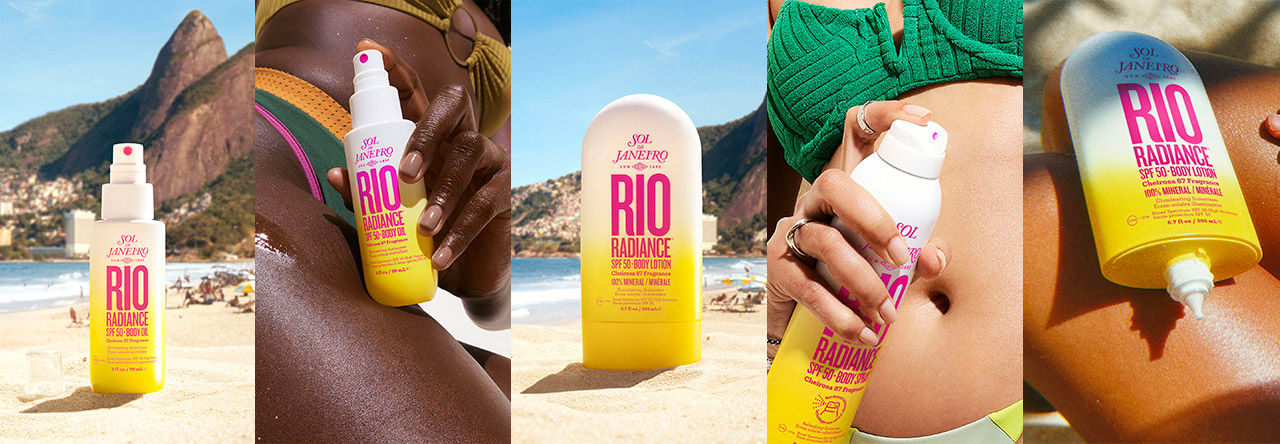Your Shopping Bag is Empty
Sunscreen Myths: Busted
It's always sunscreen season, and we need it every single day. With summer approaching, it makes it even more important. You might be asking yourself, what sunscreen should I use? Or, you may be wondering: do I need SPF everyday? We are here to bust all the myths you may have heard about sunscreen, to make you feel confident in your sun protection. Remember, SPF is your BFF!
The right sun care for you is the one you love to wear. Not found a sunscreen you love just yet? It's all about trial and error to match the texture and coverage you need. Shop sunscreen worthy of your skin™ from Sol De Janeiro Rio Radiance range online and in-store now.
MYTH
Layering sunscreen increases the SPF.
BUSTED
The level of protection provided by the highest SPF product used is the maximum protection you'll receive. Layering SPF products doesn't increase the SPF level beyond the highest value.
MYTH
Sunscreen with high SPF does not need to be reapplied often.
BUSTED
The SPF number refers to how much protection you're get from the sunscreen, not how long it lasts. We recommend reapplying every 2 hours while exposed to the sun.
MYTH
Dark skin doesn't need sunscreen.
BUSTED
While it is true that melanin helps to block out UV rays, all skin tones are susceptible to damage at different rates. This can be prevented with sunscreen.
MYTH
The sun won't damage the skin if it's cloudy.
BUSTED
UV rays can still penetrate through clouds and reflect off snow and water, causing damage to the skin. It is important to wear sunscreen even while it is dull outside.
MYTH
You don't need to apply sunscreen if your makeup has SPF.
BUSTED
More often than not, we don't wear enough makeup for optimal protection, and may not cover all areas needed. Layer sunscreen under makeup for the best coverage.
MYTH
I don't need sunscreen indoors, I work from home!
BUSTED
Blue light is omitted from smartphones and computers, and can penetrate even deeper than UVA rays, so it is important to use SPF every day, even if indoors.
MYTH
Sunscreen leaves a white cast.
BUSTED
The formulations of sunscreens have come a long way in recent years which has led to sunscreens that are lightweight and non-comedogenic, offering optimal protection with a texture you will prefer.
MYTH
You can use the same sunscreen on the face and body.
BUSTED
Facial sunscreen is usually non-comedogenic, and not harsh on the skin. As the face has more sensitive skin than the body, lighter sunscreen is needed here.
MYTH
Sunscreen causes Vitamin D deficiency.
BUSTED
While sunscreen can reduce vitamin D synthesis in the skin, most people still get enough vitamin D through diet. The benefits of sunscreen outweigh any risks associated with vitamin D deficiency.
Sunscreen FAQs
What is the difference in UVA and UVB rays?
Simply put, UVA rays = aging rays. UVB rays = burning rays. UVA rays don't cause a burn, but they do cause: fine lines, dark spots, pigmentation and more. They are equally strong all year, not just summer. UVB rays burn and damage the skin.
What is SPF?
Sun Protection Factor. A measure of protection from UVB rays, this indicates how long you can stay in the sun without experiencing overexposure.
What does PA mean in sunscreen?
This is used to indicate the level of UVA protection a sunscreen offers. The system ranges from PA+ to PA++++. The more plus signs, the more protection from aging rays.
What does broad spectrum mean?
This means that the sunscreen has SPF and PA rating, meaning you are protected from both UVA and UVB rays.
What is the difference in physical and chemical sunscreen?
Mineral sunscreen also known as physical sunscreen, creates a physical barrier that reflects and scatters UV. Chemical sunscreen also known as organic sunscreen, absorbs UV rays and transform them into heat.
